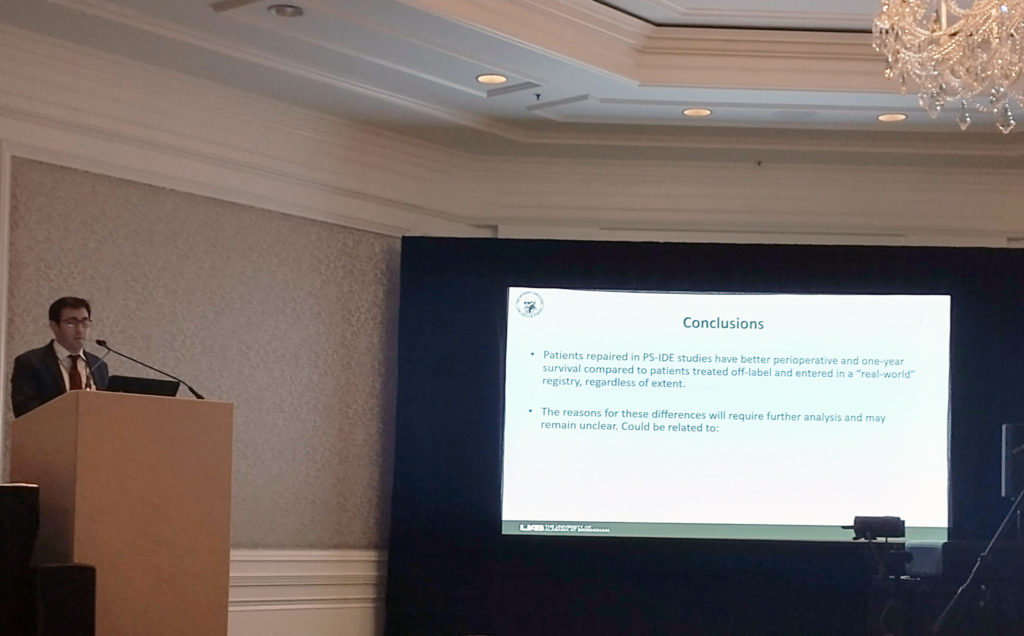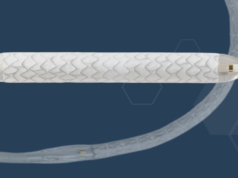
Patients treated in Food and Drug Administration (FDA)-approved investigational device exemption (IDE) trials for complex thoracoabdominal aortic aneurysms (TAAAs) in the U.S. Aortic Research Consortium (ARC) had better 30-day and one-year survival compared with those recorded in the real-world Vascular Quality Initiative (VQI) registry, new data presented at the 2022 Southern Association for Vascular Surgery (SAVS) annual meeting revealed.
Results from the consortium’s retrospective analysis of U.S. ARC and VQI procedures carried out between 2011–2019 were delivered by Ryan Heslin, BS, a medical student at the University of South Alabama College of Medicine in Birmingham, Alabama, with senior author Adam Beck, MD, vascular division director at the University of Alabama at Birmingham and one of the IDE investigators, present as a moderator of the scientific session in which the paper featured.
The research team aimed to compare the real-world setting of the Society for Vascular Surgery (SVS) VQI database to that of the now 10-strong physician-sponsored U.S. ARC trials in order to evaluate the effect of custom-built or off-the-shelf fenestrated/branched endovascular devices. Despite the fact there are no commercially available devices for the repair of TAAAs in the U.S., an increasing number of patients are felt to be at high risk for open repair and are therefore undergoing endovascular repair, Heslin noted.
“These data are collected in the SVS VQI registry,” he said. “The U.S. Aortic Research Consortium has access to these custom-built branched/fenestrated endovascular devices that are designed to match patients and are not present in the VQI.”
The analysis of 3,212 patients—all of whom underwent elective procedures for asymptomatic, non-ruptured aneurysms, and had defined zones of endograft deployment—showed a 30-day mortality rate of 6.1% in the VQI vs. 2% in the U.S. ARC for Crawford classification system extent 4 TAAAs. At one year, the equivalent rates were 12.3% (VQI) vs. 8.4% (ARC). Similarly, 30-day and one-year mortality in the cases of extent 1–3 and 5 aneurysms were 7.3% (VQI) vs. 2.6% (ARC), and 16.3% vs. 13.1%, respectively.
“The appearance of our Kaplan Meier survival curves mostly mirror our findings at 30 days and one year, with a significant drop off in the perioperative period for the VQI group, but a significant difference in survival was noted in both groups,” Heslin added.
Commenting on the idiosyncrasies two registries, Heslin explained that though the patient populations studied are similar in terms of pathology, “the conditions under which they are studied are quite different.” He continued: “The VQI represents real-world practice using off-label techniques, including physician-modified grafts [PMEGs] and parallel-stenting techniques. This dataset allows us to evaluate endovascular techniques outside of clinical trial settings, and thus is much more representative of the general population.
“The U.S. ARC is a group of investigators with physician-sponsored IDEs that has access to endovascular repair using custom-built or off-the-shelf medical devices. This allows us to evaluate the outcomes of endovascular repair in a clinical trial setting. It is important to know these patients are highly selected for and studies are under heavy scrutiny from multiple avenues.” Heslin pointed out that the researchers had elected to study Crawford extent 4 aneurysms separately from extents 1–3 and 5 mostly because of overall volume, their lack of a thoracic component, and differences in overall management.
Notable differences among extent 4 patients in the U.S. ARC population included the fact they were more often Caucasian, male and in possession of a history of coronary artery disease (CAD), he said. The VQI equivalent patients more commonly had a history of chronic obstructive pulmonary disease (COPD) and diabetes. Those with extent 1–3 and 5 aneurysms in the ARC dataset were more likely to be older by about a year, Caucasian, and have a history of CAD. Their VQI counterparts were more likely to have a history of congestive heart failure and COPD. “It is important to note that maximal aneurysm diameter did not vary across the VQI or ARC datasets in any Crawford extent,” said Heslin.
He conceded certain limitations to the study. “We did not evaluate risk-adjusted mortality,” he began. “While patients overall had similar comorbidities, disease-specific death was not used to compare overall survival. We believe that risk adjusting this type of analysis removes the clinical decision-making that is critical in these elective procedures in complex aneurysms. Additionally, we did not evaluate long-term mortality after one year. We believe that 30-day mortality likely represents procedural success in patient selection, and one-year mortality is indicative more specifically of patient selection.
“Although reintervention and device or aortic failures may impact longer-term survival, this is likely more impacted by patient factors such as age and comorbidities, as well as unmeasured outcomes such as cancer-related deaths. In summary, in both the ARC and VQI cohorts, more extensive aneurysms, extents 1, 2, 3 and 5, have poorer survival at 30 days and one year. Survival at 30 days and one year was statistically better for ARC patients in both groups.”
The challenges faced in repairing TAAAs with endovascular devices has bred brisk surgeon activity in the arena, Heslin commented. “Limitations of endovascular repair have largely been challenges related to the inclusion of aortic branches, thus patients needed to be anatomically suitable for optimal repair,” he said. “This problem has inspired numerous and creative ways that vascular surgeons have continued to approach thoracoabdominal aneurysm repair, including PMEGs, parallel-stenting grafts and other techniques, and most-recently custom or purpose-built endografts designed to specifically match patient anatomy.”
That’s where the IDE trials come in.
Concluding, Heslin highlighted that the IDE trial patients studied had better perioperative and one-year survival compared to patients treated off label or entered in a real-world registry, regardless of extent.
“The reasons for these differences require further analysis and remain unclear,” he said. “A couple of things they could be related to would be differences in devices or device durability, differences in device comorbidity profiles, the intangible surgeon and patient psychosocial factors related to when, whether and how to repair these aneurysms, as well as volume-related outcomes. All of these IDE centers have dedicated teams of research coordinators and nurses. These include dedicated resources and additional infrastructure that help manage those patients. This allows for a more programmatic approach to each patient, which likely contributes to better outcomes.”
Designated discussant Michol A. Cooper, MD, an assistant professor in the division of vascular surgery and endovascular therapy at the University of Florida College of Medicine in Gainesville, Florida, asked for further comment on the survival curves, saying: “Although the overall mortality for the VQI is greater for patients in both groups, based on the Kaplan Meier curves, the majority of the difference appears to be in the initial postoperative period, after which the mortality curves parallel each other.”
Heslin pondered several possibilities associated with a “really high” relative risk of perioperative mortality. “We discussed patient selection and procedural success previously, which we believe certainly could play a role. Additionally, it could be related to a high-volume center. You could have staff and nurses and dedicated teams, like there is in the IDEs, that are much more comfortable managing the complications that may arise. So, successfully managing these perioperative complications may additionally lead to decreased perioperative mortality as well.”
The data also prompted Murray Shames, MD, chief of vascular surgery at the University of South Florida (USF) Health Morsani College of Medicine in Tampa, Florida, to ask Heslin whether “industry has a responsibility to expand access if it is shown that [these] devices are better than what is being done in the real world.” The rest of the world has access to such devices, he said. “Europe has devices, Asia has devices, Australia has devices, and we are still limited to [the IDE] sites.”
U.S. ARC investigator and session moderator Beck stepped in, arguing that responsibility also falls upon the FDA to expand access. “These things are going to be expanded,” he said. “It is just going to take time. Unfortunately, we may be talking about five or 10 years down the road before these things are available.”
Shames said his institution has two IDE trials of its own—one involving purpose-built and the other PMEG devices. Beck reasoned that PMEG IDEs “would be really interesting to study in addition to the VQI data, which are non-IDE PMEG devices, essentially.” David Minion, MD, a professor of surgery at the University of Kentucky in Lexington, Kentucky, added that specialists faced a reproducibility crisis. “Seventy percent of all studies are not reproducible.” He wondered whether the right question was being asked: “Is it getting more access to more centers? How do we deal with that crisis of being able to compare these things?”












